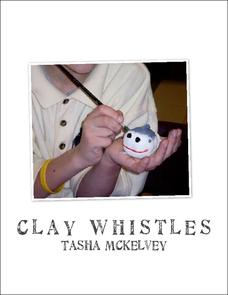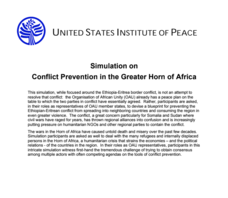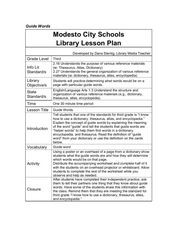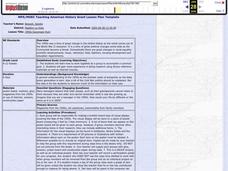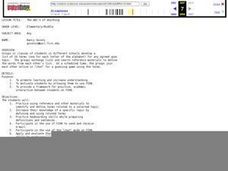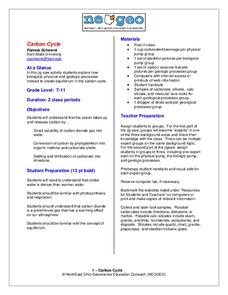Tasha McKelvey
Clay Whistles
Create clay whistles with your elementary or middle school students. The project is outlined in great detail here, complete with step-by-step photographs, finished examples, a materials list, student handouts, and a rubric. Students...
CC Homestead
Summarize
Designed for third graders but appropriate for older learners as well, this packet of materials underscores the necessity of teaching kids how to summarize, how to identify main ideas and supporting details, and how to ask questions...
Urbana School District
Thermodynamics
Entropy, it isn't what it used to be. Presentation includes kinetic-molecular theory, heat and internal energy, thermal equilibrium, temperature scales, laws of thermodynamics, entropy, latent heat of fusion, specific heat, calorimetry,...
US Institute of Peace
Simulation on Conflict Prevention in the Greater Horn of Africa
Is containing a conflict possible in the Horn of Africa? Young peacekeepers engage in a simulation that examines the multi-faceted conflict that exists between the countries of Ethiopia and Eritrea. Representatives from ten countries in...
Judicial Learning Center
The Constitution and Rights
What's the right way to teach young historians about the Bill of Rights? Many an instructor has asked this question when pondering lesson plans over the US Constitution. The Constitution and Rights is a nifty resource that provides a...
Curated OER
Does it Measure Up?
Use this fun activity with youngsters learning how to use rules for measurement. Each is provided with six steps that direct them to draw specific things with specific heights or lengths. For example, they start by drawing a tree that is...
Curated OER
Anticipation Guides Improve Reading Comprehension
Beginning with anticipation guide strategies is a powerful method for improving reading comprehension. First, list initial ideas for a topic the class will be reading about. These ideas are formulated into statements, some of which are...
Curated OER
You Smoke You Croak
Sixth graders investigate the effects of tobacco. In this personal health instructional activity, 6th graders use print and Internet sources to research the effects of smoking. Students create PowerPoint presentations using their...
Curated OER
Maps
If your students are just starting a unit on Geography this could be the introduction you're looking for. This PowerPoint presents a clear and organized overview of the different types of maps people use and why each is important. Tip:...
Curated OER
Boat Safety and Water Sports - Lesson 18 - Wake Board Terms
Boat safety lesson 18 is all about the wake board. The class learns the terminology about wake boards and discusses the different types of ropes used. Much of the information regarding boating basics, personal floatation devices,...
PB Works
“George Washington’s Socks”: Vocabulary Part 1
Supplement a class reading of George Washington's Socks with this list of vocabulary words. Including a mixture of verbs, nouns, adjectives, and adverbs, this resource asks young readers to record the page number and a synonym for...
Curated OER
Life Cycles in the Rain Forest Research
In this life cycles in the rain forest research worksheet, students use reference materials and the Internet to collect information about the life cycles of animals that live in the rain forest. They fill in the name of the animal and...
Curated OER
New Hampshire Research Worksheet
In this New Hampshire research worksheet, students use reference materials to answer 8 questions. They answer questions about the state's geography, politics, and interesting facts.
Curated OER
Formal and Informal Language
ESL students use the graphic organizers to record different phrases of speech with an emphasis upon the use of slang.
Curated OER
Guide Words
Third graders investigate guide words. In this library lesson, 3rd graders investigate guide words in reference materials and complete an alphabetizing worksheet.
Curated OER
The Solution to Pollution is Dilution
Students consider what happens to herbicides or insecticides that are used in agricultural practices, especially herbicides that are used to control noxious weeds. They become acquaint with a chemical assessment method known as...
Curated OER
Recycled Materials
Students examine the properties and uses of recyclable materials. For this recycled materials lesson, students are introduced to the idea that some materials can be recycled. They investigate the types of materials that can be reused,...
Curated OER
Covering the News
Students compare the coverage of two crime stories Using local or national newspapers, news magazines and other reference materials, each group trace the "unfolding" of two crime stories: The Laci Peterson investigation plus one students
Curated OER
1950's Scavenger Hunt
Students encounter how to work together as a group to accomplish a common goal. They gain more experience in doing research using library reference materials as well as internet sources. Each group is responsible for making a bulletin...
Curated OER
Materials 2: Recycled Materials
Students are introduced to the idea that some materials can be recycled. They will investigate the types of materials that can be reused, as well as potential uses for each type of recyclable material.
Curated OER
The ABC'S of Anything
Students practice using reference and other materials to identify and define related to a selected topic. They practice keyboarding skills while preparing definitions and senteces. Students participate in the use of FIRN to send and...
NorthEast Ohio Geoscience Education Outreach
Carbon Cycle
Using a jigsaw approach, earth science experts teach each other about the physical, biological, and geologic components of the carbon cycle, with a specific focus on the ocean.
Curated OER
Multiplication Tables Using Microsoft Excel
Eighth graders are introduced to Microsoft Excel as a computer application software program. They create multiplication tables in Microsoft Excel. Students work in small groups. They discuss the $ (anchor) function in Microsoft Excel.
EngageNY
Construct an Equilateral Triangle (part 2)
Triangles, triangles, and more triangles! In this second installment of a 36-part series, your young mathematicians explore two increasingly challenging constructions, requiring them to develop a way to construct three triangles that...
